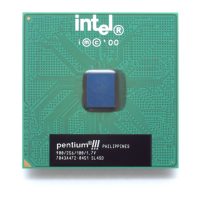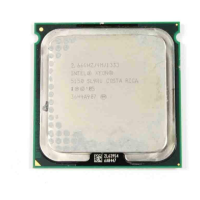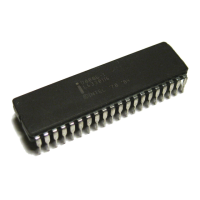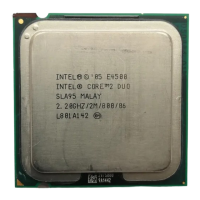22 Datasheet
Electrical Specifications
NOTES:
1. Refer to Section 4.2 for signal descriptions.
2. In processor systems where there is no debug port implemented on the system board, these signals are used
to support a debug port interposer. In systems with the debug port implemented on the system board, these
signals are no connects.
3. The value of these signals during the active-to-inactive edge of RESET# defines the processor configuration
options. See Section 6.1 for details.
.
2.7 GTL+ Asynchronous Signals
Legacy input signals such as A20M#, IGNNE#, INIT#, SMI#, and STPCLK# use CMOS input
buffers. All of these signals follow the same DC requirements as GTL+ signals, however the
outputs are not actively driven high (during a logical 0 to 1 transition) by the processor. These
signals do not have setup or hold time specifications in relation to BCLK[1:0].
All of the GTL+ Asynchronous signals are required to be asserted/de-asserted for at least six
BCLKs for the processor to recognize the proper signal state. See Section 6.2 for additional timing
requirements for entering and leaving the low power states.
Table 2-4. Signal Characteristics
Signals with R
TT
Signals with no R
TT
A[35:3]#, ADS#, ADSTB[1:0]#, AP[1:0]#, BINIT#,
BNR#, BOOTSELECT
1
, BPRI#, D[63:0]#, DBI[3:0]#,
DBSY#, DEFER#, DP[3:0]#, DRDY#, DSTBN[3:0]#,
DSTBP[3:0]#, HIT#, HITM#, LOCK#, MCERR#,
PROCHOT#, REQ[4:0]#, RS[2:0]#, RSP#, TRDY#
NOTES:
1. The BOOTSELECT signal has a 500-5000 Ω pull-up to V
TT
rather than on-die termination.
A20M#, BCLK[1:0], BPM[5:0]#, BR0#, BSEL[2:0],
COMP[1:0], FERR#/PBE#, IERR#, IGNNE#, INIT#,
LINT0/INTR, LINT1/NMI, PWRGOOD, RESET#,
SKTOCC#, SMI#, STPCLK#, TDO, TESTHI[13:0],
THERMDA, THERMDC, THERMTRIP#, VID[5:0],
VTTPWRGD, GTLREF, TCK, TDI, TRST#, TMS
Open Drain Signals
2
2. Signals that do not have R
TT
, nor are actively driven to their high-voltage level.
BSEL[2:0], VID[5:0], THERMTRIP#, FERR#/PBE#,
IERR#, BPM[5:0]#, BR0#, TDO, VTT_SEL, LL_ID[1:0],
MSID[1:0]
Table 2-5. Signal Reference Voltages
GTLREF V
TT
/2
BPM[5:0]#, LINT0/INTR, LINT1/NMI, RESET#, BINIT#,
BNR#, HIT#, HITM#, MCERR#, PROCHOT#, BR0#,
A[35:0]#, ADS#, ADSTB[1:0]#, AP[1:0]#, BPRI#, D[63:0]#,
DBI[3:0]#, DBSY#, DEFER#, DP[3:0]#, DRDY#,
DSTBN[3:0]#, DSTBP[3:0]#, LOCK#, REQ[4:0]#, RS[2:0]#,
RSP#, TRDY#
BOOTSELECT, VTTPWRGD, A20M#,
IGNNE#, INIT#, PWRGOOD
1
, SMI#,
STPCLK#, TCK
1
, TDI
1
, TMS
1
, TRST#
1
NOTES:
1. These signals also have hysteresis added to the reference voltage. See Table 2-13 for more information.

